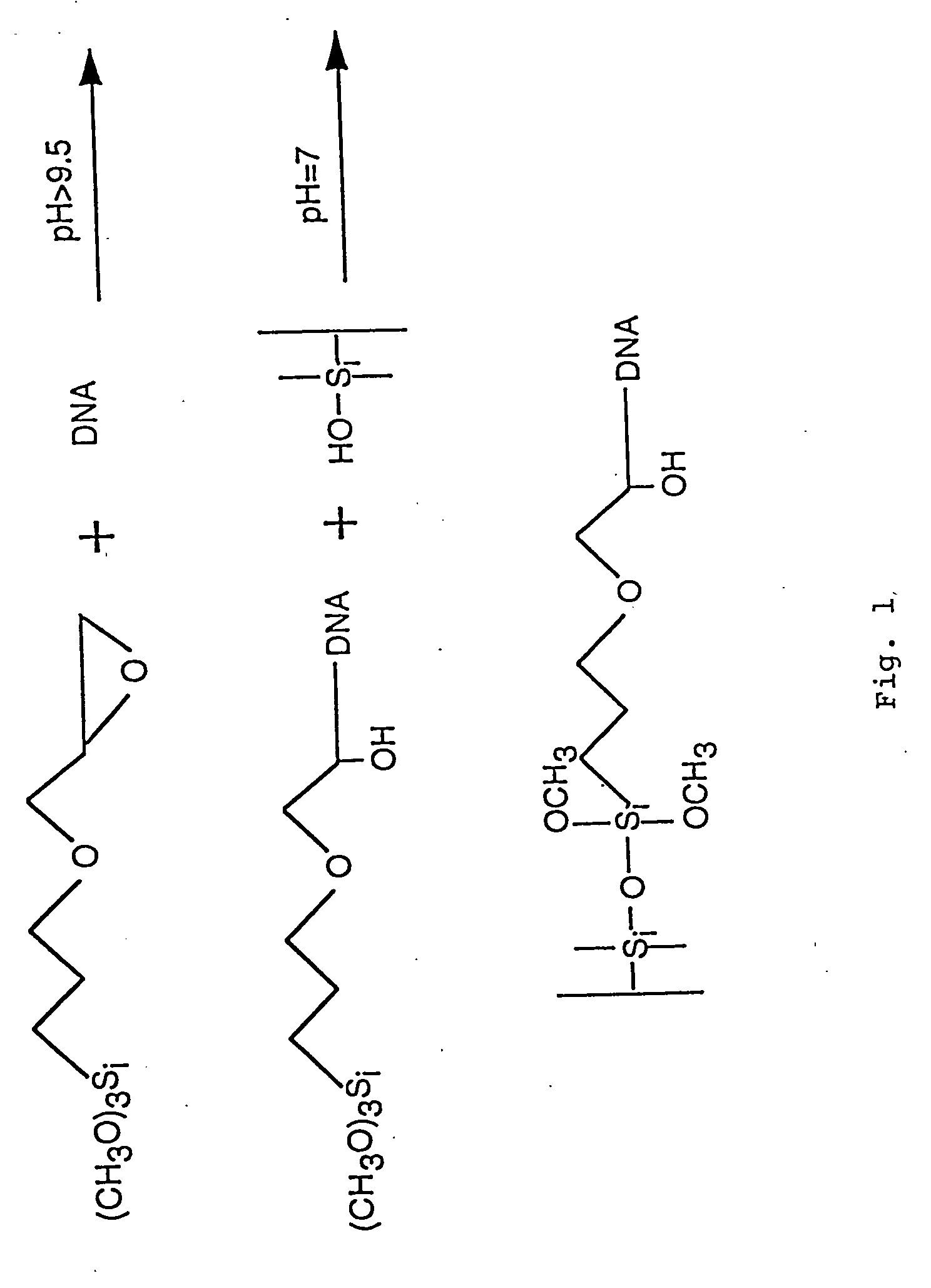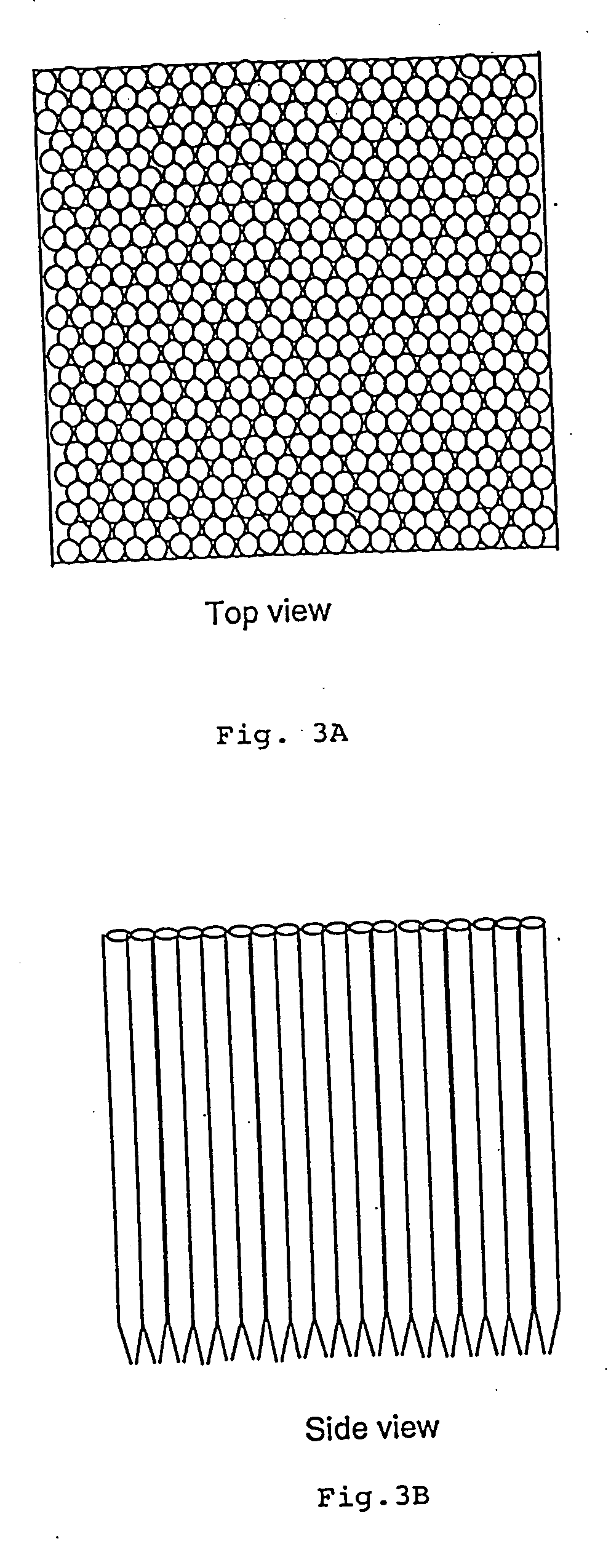Chemically modified biological molecules and methods for coupling biological molecules to solid support
a biological and chemical modification technology, applied in the field of compounds, can solve the problems of net positive electrostatic charge on the glass surface, rusty investigation, and activated derivatization, and achieve the effects of easy derivatization, high detection sensitivity, and quick reaction ra
- Summary
- Abstract
- Description
- Claims
- Application Information
AI Technical Summary
Benefits of technology
Problems solved by technology
Method used
Image
Examples
example 1
Preparation of Modified Nucleic Acid Using 3-glycidoxypropyltrimethoxysilane
This example describes one form of modified nucleic acid of the present invention. The purpose of the chemical modification is to enable the nucleic acid to be readily affixed to an underivatized solid surface. In this example, the nucleic acid—preferably DNA—is modified by reaction with 3-glycidoxypropyltrimethoxysilane (GPTS), according to FIG. 1. GPTS has in fact been previously used to derivatize a glass surface upon which (unmodified) DNA samples are then contacted and immobilized. Yet the use of GPTS is for the opposite purpose: to modify the DNA for subsequent attachment to an underivatized glass surface has not been previously disclosed nor suggested. Moreover, GPTS—since it contains an epoxide group—is known to damage DNA in vivo. For these reasons, its use to derivatize DNA is actually discouraged by the prior art.
Schematically, affixing the nucleic acid to the solid support consists essentiall...
example 2
Preparation of Modified Nucleic Acid Using 3-aminopropyltriethoxysilane
This example describes another preferred form of modified nucleic acid of the present invention. The purpose of the chemical modification is to enable the nucleic acid to be readily affixed to an underivatized solid surface. In this example, the nucleic acid, preferably DNA, is modified by reaction with 3-aminopropyltrimethoxysilane, according to FIG. 2. As in example 1, affixing the nucleic acid to the solid support consists essentially of two steps. In the first, the nucleic acid reacts with the epoxide end of the 3-aminopropyltrimethoxysilane molecule; in the second step, the glass surface reacts with the other end, or the silane end of the 3-aminopropyltrimethoxysilane-modified nucleic acid, thereby affixing the nucleic acid onto an underivatized glass surface.
As in example 1, the entire reaction is rapid, is characterized by a favorable equilibrium, and occurs under very mild conditions using a minimum o...
example 3
Preparation of a High-Density Microarray
Once the modified nucleic acids of the present invention, such as those described in Examples 1 and 2, are prepared, they can then be exploited. Again, these modified nucleic acids (particularly DNA) can be immobilized onto a glass surface simply by contacting the modified DNA onto the underivatized surface. The significance of this is, among other things, that spreading (migration of the DNA sought to be immobilized from the desired location) and non-specific probe sticking (caused by derivatization of the glass surface which creates a net positive electrostatic charge upon the surface which attracts the net negatively charged DNA) are essentially eliminated.
These advantages allow the creation of extraordinarily high-density microarrays, which is highly desirable. For instance, due to the elimination of spreading, and the effective elimination of probe sticking, a single small glass surface can contain virtually thousands of DNA samples t...
PUM
| Property | Measurement | Unit |
|---|---|---|
| diameter | aaaaa | aaaaa |
| sizes | aaaaa | aaaaa |
| pH | aaaaa | aaaaa |
Abstract
Description
Claims
Application Information
 Login to View More
Login to View More - R&D
- Intellectual Property
- Life Sciences
- Materials
- Tech Scout
- Unparalleled Data Quality
- Higher Quality Content
- 60% Fewer Hallucinations
Browse by: Latest US Patents, China's latest patents, Technical Efficacy Thesaurus, Application Domain, Technology Topic, Popular Technical Reports.
© 2025 PatSnap. All rights reserved.Legal|Privacy policy|Modern Slavery Act Transparency Statement|Sitemap|About US| Contact US: help@patsnap.com



